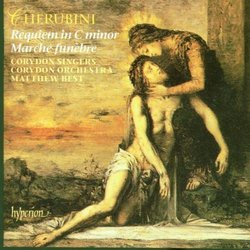| All Artists: Luigi Cherubini, Matthew Best, Maciej Rakowski, Corydon Orchestra Title: Cherubini: Requiem in C minor; Marche funèbre Members Wishing: 0 Total Copies: 0 Label: Hyperion UK Release Date: 2/9/1996 Album Type: Import Genre: Classical Styles: Opera & Classical Vocal, Historical Periods, Classical (c.1770-1830), Early Music Number of Discs: 1 SwapaCD Credits: 1 UPCs: 034571168050, 034571168050 |
Search - Luigi Cherubini, Matthew Best, Maciej Rakowski :: Cherubini: Requiem in C minor; Marche funèbre
 | Luigi Cherubini, Matthew Best, Maciej Rakowski Cherubini: Requiem in C minor; Marche funèbre Genre: Classical |
Larger Image |
CD DetailsSimilarly Requested CDs
|
CD ReviewsOne of the best versions of Cherubini's work Jeff Lee | 01/01/1998 (5 out of 5 stars) "There are many requiems in existence. Despite the heavily religious overtones of Roman Catholicism and the terrors of the centerpiece Dies Irae poem, the requiem mass is almost as versatile as a symphony. Bombastic and grand comes in the form of Verdi's and Berlioz's Requiem; quite and comforting comes in the form of Faure's and Durufle's masses; but I feel that Cherubini, a not-well known composer, wrote a mass that is more akin to Mozart's: beautiful, touching, yet cold and unsettling. Cherubini wrote two settings of the requiem: this is the first. First off, I must say that it is a truly awe-inspiring work, though it must lack the grandeur of Berlioz's Grande Messe des Mortes and the operatic mechanisms of Verdi's Messa da Requiem. Still, Cherubini wrote a beautiful piece of music. The opening Requiem and Kyrie inspire nothing but quiet and melancholy thoughts in the mind. The Graduale is in my opinion the finest of its kind, a slowly shifting movement that begins uncertainly. The Dies Irae, true to its doomsday nature, is terror-inspiring and almost overwhelming at moments. In its Tuba Mirum, brass are called forth for the Final Judgment in a picture as vivid as Verdi's "insurpassable" Tuba Mirum. The Rex Tremendae Majestatis, whilst invoking the same musical lines of Tuba Mirum, struck me the hardest here: it is nothing but the inspiring magnificence the poem demands. Finally, Lacrimosa dies illa ends the long sequence. The Offertorium, though not extremely impressive, was not mediocre and certainly satisfying. The Quam Olim Cherubini chose to set like many other composers, including Mozart and Biber: in a fugue. When well performed, as here, the Offertorium becomes rather like an adventure in a musical world, for it shifts from scene to scene. Following the Quam Olim Abrahae is the Sanctus: some call it dull, but whilst the Sanctus lacks the divine grandeur we see in such masses as the Verdi, Berlioz, and Mozart, it is not lacking in beauty. The movement rolls out very smoothly, very "rounded", and the opening strains of "sanctus" by the soprano are certainly well done in this recording. The Agnus Dei concludes the work: titanic, rushing down contrasted with quiet moments of the Lux Aeterna. I found this recording to be the best out of all the recordings I have heard of Cherubini's Requiem in C. The Corydon Singers and Matthew Best do very well in their interpretation of the mass, and they certainly don't have the pronounciation quirks (though done deliberately) and the breaking up moments of the Dies Irae that the Opus 111 recording has. Certainly, this is a recording to hear. END"
|



